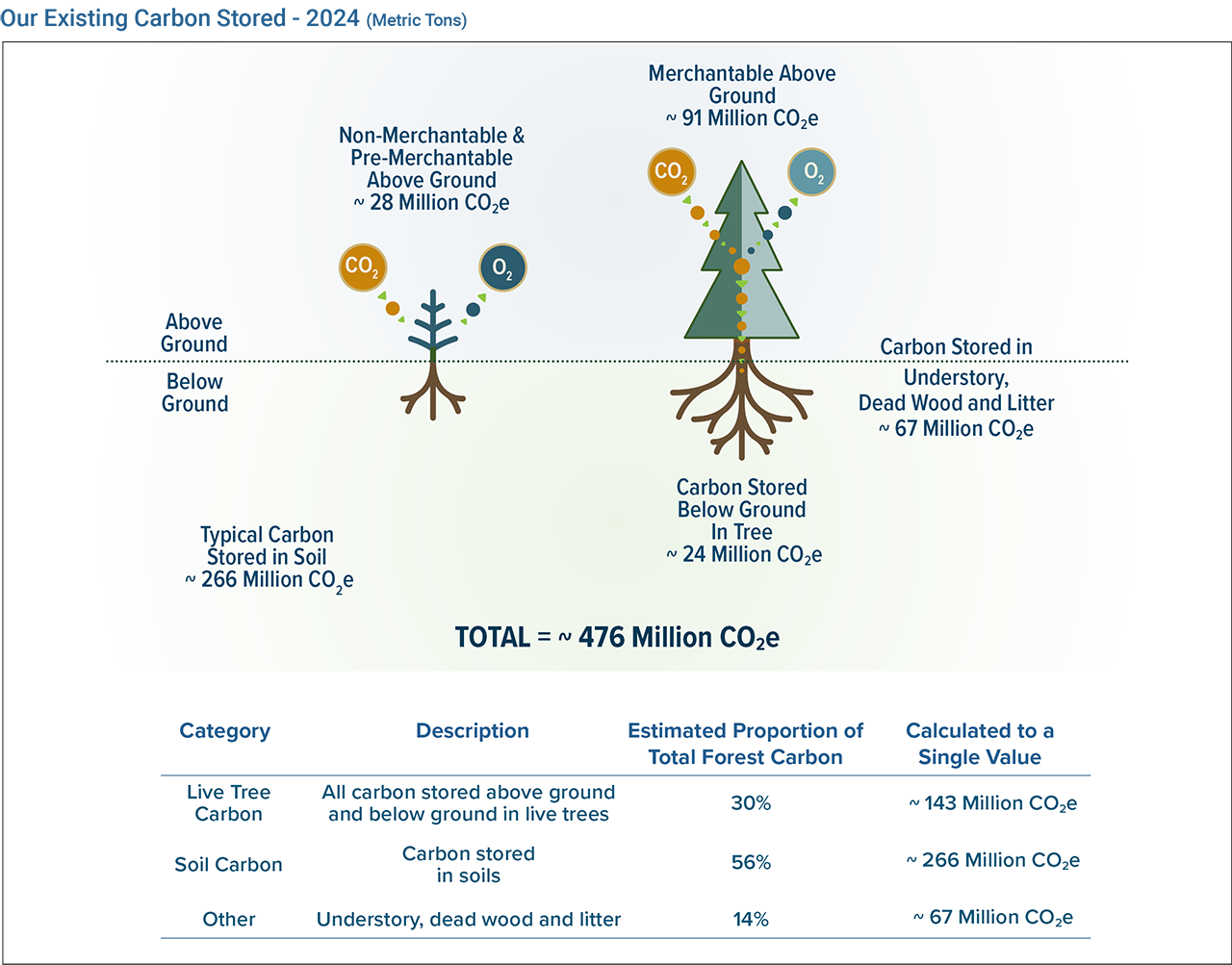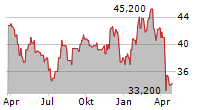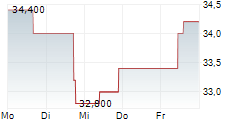NORTHAMPTON, MA / ACCESS Newswire / June 13, 2025 / We have divided our forest carbon stocks into three pools that allow us to track our carbon inventory and to follow and account for stored carbon when timber is harvested. The three pools are: 1) merchantable portions of trees, 2) above ground non-merchantable portions of merchantable trees and pre-merchantable trees, and 3) below ground portions of all trees (excludes soil carbon).
Our forests, on all lands owned at the end of 2024, stored a total of 143 million metric tons of CO2e in all three pools. Merchantable above ground portions accounted for 91 million metric tons of CO2e; 28 million metric tons of CO2e were in pre-merchantable and above ground portions; and 24 million metric tons were in below ground portions of trees.1
The carbon stored in forest soils accounts for approximately 56% of forest carbon stocks and is a major component of the contribution of forests as a natural climate solution.2 Soil carbon pools can be dynamic over long periods of time, but they do not flux in predictable, reportable ways like above ground carbon does in response to annual tree growth and harvest. The U.S. Forest Service Forest Inventory and Analysis Program is continuing to develop methods to accurately measure soil organic carbon (SOC) and include estimates in their reporting.3 Utilizing the most recent regional estimates of SOC measured to a depth of 100 cm, our Idaho soils are storing ~100 million metric tons of CO2e, our South soils are storing ~166 million metric tons of CO2e, and our ownership is storing ~67 million metric tons of CO2e in the understory and dead wood. For our ownership, the combined total tree carbon, soil carbon, and understory and dead wood is ~476 million metric tons of CO2e and is a result of our lands being maintained in working forest conditions.
Carbon from harvested wood remains in wood and paper products until the end of their use and eventual decay. The rate of decrease in storage is dependent on the specific product end use. Approximately 68% of total tree carbon in a sawlog-sized tree is transported to a sawmill and 55% of that amount is captured in solid wood products, such as lumber and plywood, as a long-lived carbon vault. The total tree carbon that is used for pulp and paper products has a shorter life span. Pulp and paper products have a rate of decay or release that is high initially as products are used, recycled, or disposed of, then the rate slows substantially after initial use because of the portion that is stored in landfills.
When wood-based products are used in place of fossil fuel-intensive products like steel or concrete, there is a permanent benefit to our atmosphere. For example, researchers have found that the CO2 intensity of lumber production is 50% less than steel and 25% less than that of cement. By building with wood, additional carbon is stored in everyday products and buildings. A wood house will store carbon until it decays or is replaced. If the wood house stands for 108 years, the forest will have regrown two to four cycles resulting in compounding carbon storage. When trees are sustainably harvested, wood continues to store carbon in the thousands of products we use every day, from paper products to lumber. Trees then regrow, repeating the cycle.
The continuing cycle of active forest management, including planting, growing, and harvesting, optimizes a forest's ability to sequester and store carbon and improves resiliency, maintaining the ability to sequester carbon in the future. The life cycle of managed forests and the production of long-lasting wood products have a significant climate benefit, with relatively low emissions associated with the production of lumber. Over multiple cycles of wood products production and forest renewal, total carbon storage increases.
Footnotes:
Carbon removal and storage calculations for 2021-2024 were completed within the Carbon Sub-model in the Fire and Fuels Extension (FFE) of the Forest Vegetation Simulator and utilizing the Jenkins J. C. 2003 National-Scale Biomass Estimators for United States Tree Species.
G. M. Domke et al., "Toward Inventory-Based Estimates of Soil Organic Carbon in Forests of the United States," Ecological Applications 27, no. 4 (April 19, 2017): https://doi.org/10.1002/eap.1516
Forest Service Forest Inventory and Analysis Program: https://www.fia.fs.usda.

View additional multimedia and more ESG storytelling from PotlatchDeltic on 3blmedia.com.
Contact Info:
Spokesperson: PotlatchDeltic
Website: https://www.3blmedia.com/profiles/potlatchdeltic
Email: info@3blmedia.com
SOURCE: PotlatchDeltic
View the original press release on ACCESS Newswire:
https://www.accessnewswire.com/newsroom/en/real-estate/potlatchdeltics-carbon-storage-1039318



